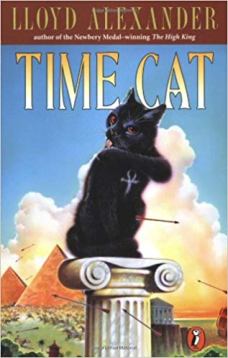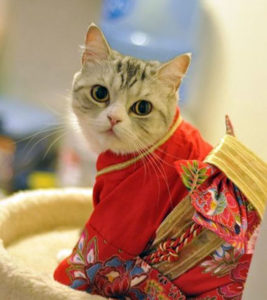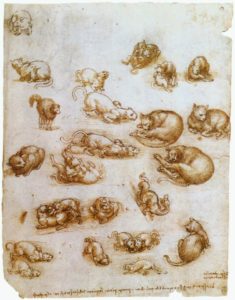I’ve been threatening with a blog post about a time-traveling cat for a while now, so here it is! I’m giving you Lloyd Alexander’s children’s fantasy Time Cat: The Remarkable Journeys of Jason and Gareth, what we’d probably call a middle grade novel today, originally published in 1963, and very much still in print, though not as well-known in the UK as (I suspect) in the USA. This was an important book for Alexander’s career as a children’s fantasy author. It came before the Prydain books, and helped him find his voice and confidence to write for children. I got interested in this book while researching my latest monograph, Celtic Myth in Contemporary Children’s Fantasy, because of the way it paved the way for Prydain – but more on this below!
Time Cat is the story of a cat, Gareth, and his human, a boy named Jason. The “mythology” of this novel is that the human folk belief that cats have nine lives isn’t quite right. As Gareth explains:
“I only have one life. With a difference… I can visit nine different lives. Anywhere, any time, any country, any century.” (p. 3)
and Gareth justifies this in terms familiar to any cat owner:
“Where do you think cats go when you’re looking all over and can’t find them?… And have you ever noticed a cat suddenly appear in a room when you were sure the room was empty? Or disappear, and you can’t imagine where he went?” (p. 3)
And, as one would expect, Gareth and Jason depart on a time-travel journey to visit nine different historical moments all over the world, in a tour clearly curated by Gareth, as all the times and places they visit have a significance for feline-human relationships!
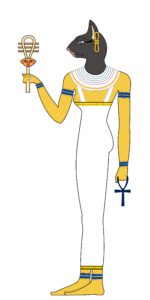
Figure 2: Bastet/Ubaste
The first place they visit is ancient Egypt, circa 2700 B.C., where cats are worshipped as part of the cult of Ubaste (or Bastet), who often appears iconographically as cat-headed. Ubaste’s symbols include the ankh, a hieroglyphic usually associated with word for “life”, which makes Gareth extra special – we learn right at the opening of the novel that Gareth is black, and that the only white spot on his chest is “a T-shaped mark with a loop over the crossbar” (p. 2), which is very clearly an ankh (see also Gareth as pictured in one of the book’s covers, Figure 1). Gareth and Jason are whisked away to King Neter-Khet, who has been looking for a special cat to please him. After some misunderstandings, they both end up teaching the king that “Not even a Pharaoh can give orders to a cat” (p. 21) – and rightly so!
Their next visit is to Rome and Britain, in 55 B.C. In Rome Gareth becomes the mascot of the “Old Cats Company” and with Jason and two Roman soldiers they sail to Gaul and from there to Britain. In the conflict between the Roman legions and the “shouting Britons” (p. 33) Gareth gets into a fight with a British wildcat and Jason is captured by a local tribe. They stay with them a while and after they educate the British to value, rather than fear, cats, the wild cat approaches the village with its kittens, one of which is clearly Gareth’s! This is the beginning of domesticated cats in Britain! (So an aetiological story, of sorts!)
Ireland in 411 A.D. is the setting of the next episode: Gareth and Jason meet Diahan, the daughter of a local king, and Sucat, the king’s herdsman. This is the episode mentioned in my book, because Sucat, a slave captured from Wales, and a Christian in a pagan land, is actually a young St Patrick!
Lloyd Alexander has originally planned a Welsh episode for this book, in which Jason and Gareth would meet St Patrick in his native Wales, before his kidnapping by Irish slave raiders. Alexander had been to Wales while serving in WWII and remembered it fondly. Also, while researching Time Cat, he had found out that St Patrick’s Welsh name meant “Good Cat” which tied up nicely with a feline-focused story. According to Alexander’s plan:
Jason and Gareth run across this young boy with a strange name, the future St. Patrick, of course. They meet him in Wales, probably in some spot where I had been myself. I can draw on my own sense of the country because I know it and am fond of it. What could be more natural than this?… They all get kidnapped by these Irishmen in a big dramatic scene… (cited in Jacobs, 1978, p. 264)
The “Welsh research” Alexander embarked upon to prepare this episode was somewhat overwhelming and brought back memories of his childhood reading and his own visit to Wales. As he noted in an interview:
something began stirring inside my head. Strange, personal stirrings began to happen to me. This was far too rich a thing to do in one chapter, so I changed my idea. Instead of having Jason and Gareth meet St. Patrick in Wales, they meet him in Ireland and it becomes an Irish episode. (Ibid., p. 265)
And, indeed, all of the rich Welsh legends Lloyd Alexander has suddenly remembered found their way into the Prydain books (more on which in my book).
As for the name Sucat and its feline associations, in Time Cat St Patrick explains that:
“In Britain, they called me Patrick. But my real name is Sucat. It means ‘Good Cat’ – and it means ‘Good Warrior.’ For in my land, the land of Wales,” he added, “we call our warriors ‘Cats.’” (p. 53)
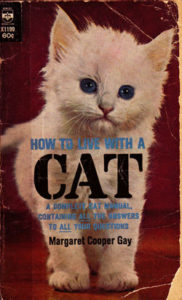
Figure 3: Margaret Cooper Gay’s How to Live with a Cat (first published in 1946)
“Succetus” is indeed recorded as one of St Patrick’s alternative names in Tírechán’s Collectanea (Account of St Patrick’s churches) from c. 670. The text itself translates what seems to be a British/Welsh name as “god of war” (see Dumville, 1993, p. 90). The somewhat fanciful translation of the name Patrick as “good cat” came from a book the name of which Alexander could no longer recall, but I’m now pretty sure it was Margaret Cooper Gay’s How to Live with a Cat (first published in 1946), in which she claims that St Patrick was originally “a Scottish monk named Su Cat” which may be translated as “Happy Warrior or the Good Cat” (Cooper Gay, 1969, p. 17). This example of Alexander repeating or adopting dubious research for “things Celtic” is something of a pattern that I’ve traced in detail in The Chronicles of Prydain in my book.[i]
The Irish episode in Time Cat brings together St Patrick and his mission, the folk belief of Ireland overridden with snakes until St Patrick banishes them (there’s an excellent scene of Gareth fighting a snake), and an element of romance between Jason and Diahan. Diahan is actually very much a prototype for Eilonwy. She is feisty, strong-minded, has “red-gold hair tossed about her soldiers” (p. 49) and chastises Jason for being impolite, or talks to him only to tell him that she won’t talk to him – all staples of Eilonwy-Taran interactions in the Prydain books.
Next stop: Japan 998 A.D. during the reign of Emperor Ichigo, when cats were introduced to Japan from China. Gareth and Jason teach the boy-Emperor Ichigo not only that cats aren’t toys to be played with and admired (and that it’s definitely NOT appropriate to dress his kittens in tiny embroidered kimonos!) but also how to find his voice and strength and assert himself over his rather nasty uncle-regent.
The fifth life Gareth and Jason visit is that of another historical figure, but this is perhaps the best-known one in the book: Italy 1468 and a young Leonardo da Vinchi, who is yet to convince his father that he doesn’t want to be a notary (as per the family tradition) but an artist. And, of course, Gareth and Jason end up becoming the catalyst for this! Leonardo, who writes his name backwards on his bedroom room (Odranoel), ends up creating a painting of a hybrid cat creature so life-like, that his father sees at last his talent. The inspiration is Gareth’s magnificent movements and feline physique. While Leonard works on drafting his painting, we literally see him producing the famous “Study sheet with cats” (Figure 5), now in the Royal Collections:
Figure 5: Leonardo da Vinci, “Study sheet with cats, dragon and other animals” (click image to see larger version)
The boy picked up a bit of charcoal and began sketching rapidly on the back of an old sheet of paper. “The thing about cats,” Leonardo said, working along until the paper was covered, “is the way they’re made. Those muscles in the back legs. Can you imagine how strong they must be? That’s why cats can jump so high. And the back, it can move almost any way, like a sword blade.
“Everything is in balance,” Leonardo went on, “all the muscles and bones and joints. That’s what I want in the painting, too.”
“Well, I hope you aren’t going to paint bones and muscles,” Jason said. “I don’t think anybody would like that.”
“Of course I’m not going to paint just bones and muscles,” Leonardo said. “But I know where they are, even if nobody else sees them. And that’s bound to make the picture better.” (p. 112)
Next, Gareth and Jason move to 16th-century Peru (1555) and meet Diego Fernández, the man who soon after became the historian of Peru for the Viceroy (who ruled in the name of the King of Spain). Don Diego’s kind nature (clearly expressed by his fondness for cats) leads to an effort towards mutual understanding between the Incas and the Spanish conquistadors (I don’t know much at all about this era, but I wouldn’t be surprised at all if the story is a rather romanticised…)
Gareth and Jason next find themselves on the Isle of Mann in 1588, where they witness a cat (called Dulcinea) and her kittens arrive by sea in a barrel, having escaped a shipwreck. And, guess what? The cat is tailless, and therefore the originator of the famous Manx cats to come (so another aetiological story). Alexander is clearly here going with one of the popular beliefs about Manx cats: that they came from one of the ships of the Spanish Armada that sunk off the coast of the Isle of Man in 1588 (on exactly the date he chooses). There is no evidence for this and Manx cats, I understand, are now believed to be the product of a natural mutation that happened on the island (perhaps because of inbreeding). But the idea of the strange cat breed coming over the sea has its narrative uses, as Dulcinea, the kittens, Gareth, and Jason, now stick together and explore the island. The human story in this episode is about a young girl who thinks herself ugly because of her unusual eyes (one blue, one brown, like those of some cats, actually) who learns to appreciate that: “Beauty is inside, not on the face… If a person thinks he’s ugly, why then he begins to act in an ugly, cruel way” (pp. 152-3). Dulcinea and her kittens stay in the Isle of Man and become ship-cats, while Gareth and Jason move on to their next adventure.

Figure 6: one of the cover designs for Time Cat
This next episode is set in Germany in 1600, where things start feeling darker. Gareth and Jason find themselves in the midst of the witch-hunts of Early Modern Europe, when cats were equally persecuted as witches’ familiars, or demonic creatures. They manage to save an innocent woman who is falsely accused for witchcraft, but the end of this story doesn’t feel as neat and comfortable as previous ones. It looks like Jason is gradually coming to terms with more difficult moral questions, with Gareth as a wise guide.
And this emphasis on growing up and learning about things that may be more complex and less black-and-white continues in last episode, set in America in 1775, just as the American War of Independence is about to break out. Gareth and Jason meet a peddler-cum-teacher-cum-inventor who travels around Massachusetts selling “nature’s finest mousetraps”, i.e. kittens, while at the same time passes on messages to and from the Sons of Liberty and facilitates the forthcoming War of Independence. As Professor Parker aptly says: “countries are like cats. They like to settle down in their own ways. But they want their freedom, too. They’ll fight for it if they have to.” (p. 193).
The ending of this story is, again, a melancholy one, and the book then ends very quickly after that, with Jason back in his own home in the 20th century (I guess they’re in the USA anyway so this is only a travel in time, not time and place at the same time) and Gareth giving a rather didactic speech about everything Jason has learned in their time-traveling journey: how to grow up. (That’s the sort of thing modern children’s literature takes great pains to avoid announcing, but it remains a perennial theme, perhaps for inevitable reasons).
The novel includes some brilliant observations of cat appearance and behaviour – see, for example, the lovely opening of the novel:
Gareth was a black cat with orange eyes. Sometimes, when he hunched his shoulders and put down his ears, he looked like an owl. When he stretched, he looked like a trickle of oil or a pair of black silk pajamas. When he sat on a window ledge, his eyes half-shut and his tail curled around him, he looked like a secret. (p. 1)
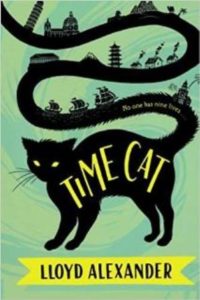
Figure 7: one of the cover designs for Time Cat
There are numerous such scenes, like the demonstration of Gareth’s hunting “moves” in the Rome/Britain episode (again, beautifully observed and really well-rendered), and various moments of Gareth expressing affection by purring, and rubbing his head and tail against ankles.
There are also a number of “proverbial” phrases of feline nature, most of the time pronounced by Gareth, but also by Jason who really does know his cat! For example:
(Jason:) “A cat can belong to you, but you can’t own him. There’s a difference.” (p. 20)
(Gareth:) “I enjoy a comfortable bed… but if there isn’t one around, it doesn’t matter. Any bed is soft to a cat.” (p. 28)
(Gareth:) “The only thing a cat worries about is what’s happening right now. As we tell the kittens, you can only wash one paw at a time.” (p. 125)
(Gareth:) “It takes patience. But that’s one thing cats have a lot of. Why, even a kitten knows if you wait long enough someone’s bound to open the door.” (p. 184)
And, at the same time, Alexander finds really apt moments to point to parallels between how people behave to cats and much larger themes such as power, faith and spirituality, self-belief and confidence, and duty and freedom.
I hope more people will discover this book. It doesn’t only fall within the sub-category of time-travel children’s fantasy, but also fits with some aspects of animal fantasy. And, as one would expect, there was a real cat which gave Alexander the inspiration for the adventures of Gareth and Jason: his cat (one of many), Solomon, who was good at appearing and disappearing as if by magic.
Let me close with Jason’s words to Gareth, which feel like an appropriate ending to this post:
“In Egypt they thought you were a god. Here [Germany during the witch-hunts] they think you’re a demon. Won’t anyone ever understand you’re a cat?”

Figure 8: one of the cover designs for Time Cat
Note
[i] There are a number of issues in Alexander’s portrayal of “Celtic” Britain and Ireland in Time Cat too, but that deserves an entire blog post in and of itself. I might write it one day, and I might call it “Of Celts and Cats”!
References
Alexander, Lloyd. Time Cat: The Remarkable Journeys of Jason and Gareth. New York: Puffin Books, 1996 [1963].
Cooper Gay, Margaret. How to Live with a Cat. [S.l.]: Simon & Schuster, 1969[1946].
Dumville, David N. Saint Patrick A.D. 493–1993. Woodbridge: Boydell Press, 1993.
Jacobs, James S. “Lloyd Alexander: A Critical Biography.” EdD diss., University of Georgia, 1978.

